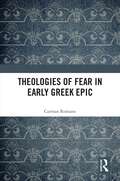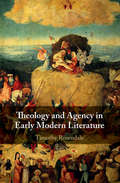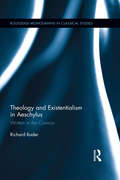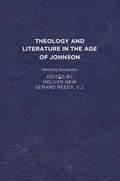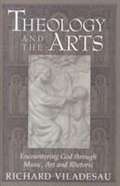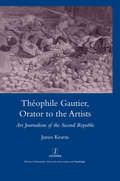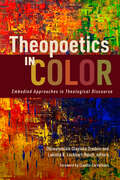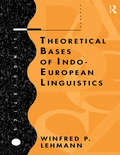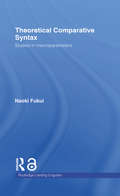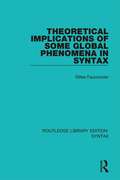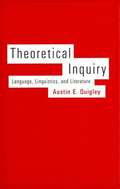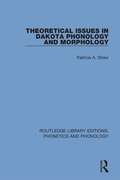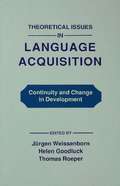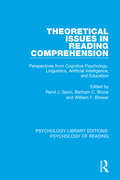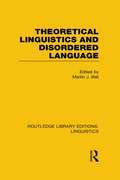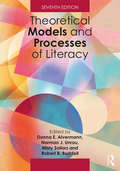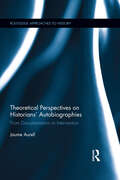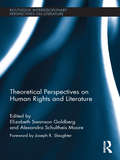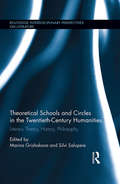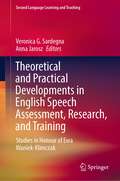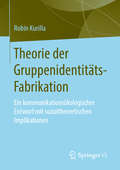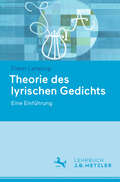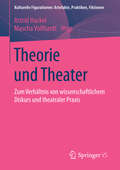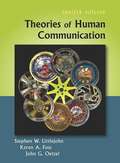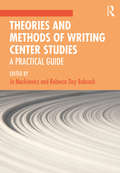- Table View
- List View
Theologies of Fear in Early Greek Epic (Routledge Monographs in Classical Studies)
by Carman RomanoThis book explores the theological significance of horror elements in the works of Hesiod and in the Homeric Hymns for the characters within these poems, the mortal audience consuming them, and the poet responsible for mythopoesis.Theologies of Fear in Early Greek Epic argues that just as modern supernatural horror fiction can be analyzed to reveal popular conceptions of the divine, so too can the horrific elements in early Greek epic. Romano develops this analogy to show how myth-makers chose to include, omit, or nuance horror elements from their narratives in order to communicate theological messages. By employing methodological approaches from religious studies, classical studies, and literary studies of supernatural horror fiction, this book brings a fresh perspective to our understanding of how the Greeks viewed their gods and how poets helped to create that view.Theologies of Fear in Early Greek Epic will be of interest to scholars in classical studies, religious studies, and comparative literature, as well as students in courses on myth, religion, and Greek culture and society.
Theology and Agency in Early Modern Literature
by Timothy RosendaleWhat can I do? To what degree do we control our own desires, actions, and fate - or not? These questions haunt us, and have done so, in various forms, for thousands of years. Timothy Rosendale explores the problem of human will and action relative to the Divine - which Luther himself identified as the central issue of the Reformation - and its manifestations in English literary texts from 1580–1670. After an introduction which outlines the broader issues from Sophocles and the Stoics to twentieth-century philosophy, the opening chapter traces the theological history of the agency problem from the New Testament to the seventeenth century. The following chapters address particular aspects of volition and salvation (will, action, struggle, and blame) in the writings of Marlowe, Kyd, Shakespeare, Ford, Herbert, Donne, and Milton, who tackle these problems with an urgency and depth that resonate with parallel concerns today.
Theology and Existentialism in Aeschylus: Written in the Cosmos (Routledge Monographs in Classical Studies)
by Richard RaderTheology and Existentialism in Aeschylus revivifies the complex question of fate and freedom in the tragedies of the famous Greek playwright. Starting with Sartre’s insights about radical existential freedom, this book shows that Aeschylus is concerned with the ethical ramifications of surrendering our lives to fatalism (gods, curses, inherited guilt) and thoroughly interrogates the plays for their complex insights into theology and human motivation. But can we reconcile the radical freedom of existentialism and the seemingly fatal world of tragedy, where gods and curses and necessities wreak havoc on individual autonomy? If forces beyond our control or comprehension are influencing our lives, what happens to choice? How are we to conceive of ethics in a world studiously indifferent to our choices? In this book, author Ric Rader demonstrates that few understood the importance of these questions better than the tragedians, whose literature dealt with a central theological concern: What is a god? And how does god affect, impinge upon, or even enable human freedom? Perhaps more importantly: If god is dead, is everything possible, or nothing? Tragedy holds the preeminent position with regard to these questions, and Aeschylus, our earliest surviving tragedian, is the best witness to these complex theological issues.
Theology and Literature in the Age of Johnson: Resisting Secularism
by John A. Dussinger Paul Tankard Frans De Bruyn Regina Janes Nicholas Seager Donald R. Wehrs Melvyn New Patrick Müller Deborah Heller Roger D. Lund E. Derek Taylor Brett C. McInelly Ryan J. Stark Robert G. Walker Steven Scherwatzky Katherine Kickel Geoff Newton Nathalie ZimpferTheology and Literature in the Age of Johnson: Resisting Secularism contains seventeen essays exploring the complex relationships between literary intentions and theological concerns of authors writing in the second half of the eighteenth century. The diversity of literary forms and subjects, from Fielding and Richardson to Burke and Wollstonecraft, is matched by a diversity of approaches and theologies. To argue that the age “resisted secularism” is by no means to argue that resistance was blindly doctrinal or rigidly uniform. The many ways secularism could be resisted is the subject of the collection. Published by University of Delaware Press. Distributed worldwide by Rutgers University Press.
Theology of the Arts: Encountering God through Music, Art and Rhetoric
by Richard ViladesauThis book explores, in a timely and engaging manner, several aspects of the relations between theology and aesthetics, in both the pastoral and academic realms. The underlying motif of this work is that beauty is a means of divine revelation, and that art is the human mediation that both enables and limits its revelatory power. Although aimed at undergraduate theology students, it will certainly capture the interest of art students, pastoral ministers and anyone who appreciates the arts.
Theophile Gautier, Orator to the Artists: Art Journalism of the Second Republic
by James Kearns"Theophile Gautier a envoye avec un feuilleton plus de trois mille personnes dans latelier de M. Ingres, wrote Champfleury in 1848. For artists, critics and readers alike, Gautier was the essential figure in French art journalism in the mid-nineteenth century. During the short-lived but pivotal period of the Second Republic, when the new administration was committed to reforming all the institutions of the fine arts, Gautier deployed the full resources of his brilliant, flexible and authoritative writing to support and direct these developments in ways compatible with his commitment to an idealist aesthetic, itself under growing pressure from alternative trends in an increasingly competitive art market. This first study of all Gautiers art journalism written during the Second Republic provides a long overdue reassessment of Gautiers importance in French nineteenth-century visual culture."
Theopoetics in Color: Embodied Approaches in Theological Discourse
by Oluwatomisin Olayinka Oredein and Lakisha R. Lockhart-RuschA collaborative book project centering the liberative theopoetics practiced by a new generation of scholars of color What is theopoetics? Once a field dominated by white liberals in the ivory tower, this embodied form of theology has flourished in the work of a new generation of scholars of color. In this groundbreaking book edited by Oluwatomisin Olayinka Oredein and Lakisha R. Lockhart-Rusch, a diverse team of theologians shows how theopoetics can be practiced &“in color.&” Featuring unconventional and artistic forms of religious reflection, this collection demonstrates how theology can become accessible when it reflects the embodied experiences of marginalized people and communities. These creative contributions defy the limitations of the white, Eurocentric academy, including such works as: • an explanation on the use of experimental theater to express theological theses • a guide to spiritual disciplines for metaphorical cyborgs seeking liberation • a meditation on the theological import of Filipino potlucks • a literary reflection on the meaning of religion to Black boys and men Diverse in scope and radical in perspective, this bold volume reclaims the liberative potential of theopoetics. Scholars and students of theology and the arts will discover inspiring new methodologies and fresh ideas in these pages. Contributors: Brian Bantum, Yara González-Justiniano, James Howard Hill Jr., Carolina Hinojosa-Cisneros, Yohana Agra Junker, Peace Pyunghwa Lee, Lakisha R. Lockhart-Rusch, Oluwatomisin Olayinka Oredein, Patrick B. Reyes, Joyce del Rosario, Tiffany U. Trent, Tamisha A. Tyler, Lis Valle-Ruiz
Theoretical Bases of Indo-European Linguistics
by Winfred P. LehmannThis book presents, for the first time in English, a complete critical survey of the theory and methodology of Indo-European linguistics, from its origins two centuries ago to the present day.
Theoretical Comparative Syntax: Studies in Macroparameters (Routledge Leading Linguists)
by Naoki FukuiCollected for the first time in a single volume, these essays and articles by Naoki Fukui form an outline of some of the most significant and formative contributions to syntactic theory. Focusing particularly on the typological differences between English/type language and Japanese/type languages, Fukui examines the abstract parameters that both link and divide them. Linguistic universals are considered in the light of cross-linguistic variation and typological (parametric) differences are investigated from the viewpoint of universal principles. The book's main focus is the nature and structure of invariant principles and parameters (variables) and how they interact to give principled accounts to a variety of seemingly unrelated differences between English and Japanese. The contrasts between these two types of language is an ideal testing ground, since the languages are superficially different in virtually every aspect of their linguistic structures from word order and wh-movement, to grammatical agreement and case-marking systems, among many others. These articles constitute a considerable contribution to the development of the principles-and-parameters model in its exploration and refinement of theoretical concepts and fundamental principles of linguistic theory, leading to some of the basic insights that lie behind the minimalist program.
Theoretical Implications of Some Global Phenomena in Syntax (Routledge Library Editions: Syntax #8)
by Gilles FauconnierThis title, first published in 1979, centres on control and binding in networks of anaphora. A wide variety of phenomena which are superficially global rather than local processes are examined, and the study deals directly with aspects of natural logic and finds its empirical motivation in concrete grammatical phenomena, thereby accounting for similarities and differences between natural languages and artificial formal logics. This title will be of interest to students of language and linguistics.
Theoretical Inquiry: Language, Linguistics, and Literature
by Austin E. QuigleyIn the aftermath of debate about the death of literary theory, Austin E. Quigley asks whether theory has failed us or we have failed literary theory. Theory can thrive, he argues, only if we understand how it can be strategically deployed to reveal what it does not presuppose. This involves the repositioning of theoretical inquiry relative to historical and critical inquiry and the repositioning of theories relative to each other. What follows is a thought-provoking reexamination of the controversial claims of pluralism in literary studies. The book explores the related roles of literary history, criticism, and theory by tracing the fascinating history of linguistics as an intellectual problem in the twentieth century. Quigley's approach clarifies the pluralistic nature of literary inquiry, the viability and life cycles of theories, the controversial status of canonicity, and the polemical nature of the culture wars by positioning them all in the context of recurring debates about language that have their earliest exemplifications in classical times.
Theoretical Issues in Dakota Phonology and Morphology (Routledge Library Editions: Phonetics and Phonology #20)
by Patricia A. ShawFirst published in 1980. This study has two basic goals. The first is to provide an explicit and coherent analysis of a variety of phonological and morphological processes within the grammars of a number of different dialects of Dakota. The second is to investigate the relevance of certain aspects of the proposed analysis to particular tenets of the general theory of transformational generative phonology and of recent proposals regarding the role of morphology within a generative framework. This title will be of great interest to students of linguistics.
Theoretical Issues in Language Acquisition: Continuity and Change in Development
by Helen Goodluck Thomas Roeper Jürgen WeissenbornIn recent linguistic theory, there has been an explosion of detailed studies of language variation. This volume applies such recent analyses to the study of child language, developing new approaches to change and variation in child grammars and revealing both early knowledge in several areas of grammar and a period of extended development in others. Topics dealt with include question formation, "subjectless" sentences, object gaps, rules for missing subject interpretation, passive sentences, rules for pronoun interpretation and argument structure. Leading developmental linguists and psycholinguists show how linguistic theory can help define and inform a theory of the dynamics of language development and its biological basis, meeting the growing need for such studies in programs in linguistics, psychology, and cognitive science.
Theoretical Issues in Reading Comprehension: Perspectives from Cognitive Psychology, Linguistics, Artificial Intelligence and Education (Psychology Library Editions: Psychology of Reading #11)
by Rand J. Spiro, Bertram C. Bruce and William F. BrewerResearch in cognitive psychology, linguistics, and artificial intelligence – the three disciplines that have the most direct application to an understanding of the mental processes in reading – is presented in this multilevel work, originally published in 1980, that attempts to provide a systematic and scientific basis for understanding and building a comprehensive theory of reading comprehension. The major focus is on understanding the processes involved in the comprehension of written text. Underlying most of the contributions is the assumption that skilled reading comprehension requires a coordination of text with context in a way that goes far beyond simply chaining together the meanings of a string of decoded words. The topics discussed are divided into five general areas: Global Issues; Text Structure; Language, Knowledge of the World, and Inference; Effects of Prior Language Experience; and Comprehension Strategies and Facilitators, and represent a broad base of methodology and data that should be of interest not only to those concerned with the reading process, but also to basic science researchers in psychology, linguistics, artificial intelligence, and related disciplines.
Theoretical Linguistics and Disordered Language: Linguistics: Theoretical Linguistics And Disordered Language (Routledge Library Editions: Linguistics)
by Martin J. BallThe rapid increase of interest in disordered speech and language among linguists over the past decade or so has resulted in many books of practical help to speech pathologists in terms of assessment and remediation. Little, however, has appeared to examine the theoretical implications of the interaction between these two fields. This book aims to fill this gap, by showing how speech pathology can inform linguistic theory and vice versa.
Theoretical Models and Processes of Literacy
by Donna E. Alvermann Norman J. Unrau Misty Sailors Robert B. RuddellThe Seventh Edition of this foundational text represents the most comprehensive source available for connecting multiple and diverse theories to literacy research, broadly defined, and features both cutting-edge and classic contributions from top scholars. Two decades into the 21st century, the Seventh Edition finds itself at a crossroads and differs from its predecessors in three major ways: the more encompassing term literacy replaces reading in the title to reflect sweeping changes in how readers and writers communicate in a digital era; the focus is on conceptual essays rather than a mix of essays and research reports in earlier volumes; and most notably, contemporary literacy models and processes enhance and extend earlier theories of reading and writing. Providing a tapestry of models and theories that have informed literacy research and instruction over the years, this volume’s strong historical grounding serves as a springboard from which new perspectives are presented. The chapters in this volume have been selected to inspire the interrogation of literacy theory and to foster its further evolution. This edition is a landmark volume in which dynamic, dialogic, and generative relations of power speak directly to the present generation of literacy theorists and researchers without losing the historical contexts that preceded them. Some additional archival essays from previous editions are available on the book’s eResource. New to the Seventh Edition: Features chapters on emerging and contemporary theories that connect directly to issues of power and contrasts new models against more established counterparts. New chapters reflect sweeping changes in how readers and writers communicate in a digital era. Slimmer volume is complemented by some chapters from previous editions available online.
Theoretical Perspectives on Historians' Autobiographies: From Documentation to Intervention (Routledge Approaches to History #15)
by Jaume AurellE. H. Carr wrote, "study the historian before you begin to study the facts." This book approaches the life, work, ideas, debates, and the context of key 20th- and 21st-century historians through an analysis of their life writing projects viewed as historiographical sources. Merging literary studies on autobiography with theories of history, it provides a systematic and detailed analysis of the autobiographies of the most outstanding historians, from the classic texts by Giambattista Vico, Edward Gibbon and Henry Adams, to the Annales historians such as Fernand Braudel, Philippe Ariès and Georges Duby, to Marxist historians such as Eric Hobsbawm and Annie Kriegel, to postmodern historians such as Carolyn Steedman, Robert A. Rosenstone, Carlos Eire, Luisa Passerini, Elisabeth Roudinesco, Gerda Lerner and Sheila Fitzpatrick, and to "interventional" historians such as Geoff Eley, Jill Ker Conway, Natalie Davis and Gabrielle Spiegel. Using a comparative approach to these texts, this book identifies six historical-autobiographical styles: humanistic, biographic, ego-historical, monographic, postmodern, and interventional. By privileging historians' autobiographies, this book proposes a renewed history of historiography, one that engages the theoretical evolution of the discipline, the way history has been interpreted by historians, and the currents of thought and ideologies that have dominated and influenced its writing in the 20th and 21st centuries.
Theoretical Perspectives on Human Rights and Literature (Routledge Interdisciplinary Perspectives on Literature)
by Joseph R. Slaughter Alexandra Schultheis Moore Elizabeth Swanson GoldbergWhat can literary theory reveal about discourses and practices of human rights, and how can human rights frameworks help to make sense of literature? How have human rights concerns shaped the literary marketplace, and how can literature impact human rights concerns? Essays in this volume theorize how both literature and reading literarily can shape understanding of human rights in productive ways. Contributors to Theoretical Perspectives on Human Rights and Literature provide a shared history of modern literature and rights; theorize how trauma, ethics, subjectivity, and witnessing shape representations of human rights violations and claims in literary texts across a range of genres (including poetry, the novel, graphic narrative, short story, testimonial, and religious fables); and consider a range of civil, political, social, economic, and cultural rights and their representations. The authors reflect on the imperial and colonial histories of human rights as well as the cynical mobilization of human rights discourses in the name of war, violence, and repression; at the same time, they take seriously Gayatri Spivak’s exhortation that human rights is something that we "cannot not want," exploring the central function of storytelling at the heart of all human rights claims, discourses, and policies.
Theoretical Schools and Circles in the Twentieth-Century Humanities: Literary Theory, History, Philosophy (Routledge Interdisciplinary Perspectives on Literature #42)
by Marina Grishakova and Silvi SalupereSchools and circles have been a major force in twentieth-century intellectual movements. They fostered circulation of ideas within and between disciplines, thus altering the shape of intellectual inquiry. This volume offers a new perspective on theoretical schools in the humanities, both as generators of conceptual knowledge and as cultural phenomena. The structuralist, semiotic, phenomenological, and hermeneutical schools and circles have had a deep impact on various disciplines ranging from literary studies to philosophy, historiography, and sociology. The volume focuses on a set of loosely interrelated groups, with a strong literary, linguistic, and semiotic component, but extends to the fields of philosophy and history—the interdisciplinary conjunctions arising from a sense of conceptual kinship. It includes chapters on unstudied or less studied groups, such as Tel Aviv School of poetics and semiotics or the research group Poetics and Hermeneutics. The volume presents a significant supplement to the standard historical accounts of literary, critical, and related theory in the twentieth century. It enhances and complicates our understanding of the twentieth-century intellectual and academic history by showing schools and circles in the state of germination, dialogue, controversy, or decline, in their respective historical and institutional settings, while reaching simultaneously beyond those dense settings to the new cultural and ideological situations of the twenty-first century.
Theoretical and Practical Developments in English Speech Assessment, Research, and Training: Studies in Honour of Ewa Waniek-Klimczak (Second Language Learning and Teaching)
by Anna Jarosz Veronica G. SardegnaThis edited book presents and discusses theoretical, practical, and research developments in English pronunciation in order to establish evidence-based directions and recommendations for best practices in English speech assessment, research, and training. It features leading pronunciation experts from diverse contexts who share cutting-edge research and valuable insights. The collection consists of six parts. Part 1 introduces the aims, focus, and structure of the book, and describes its intended audience. Part 2 reviews, provides empirical evidence, and offers critical analyses guiding different aspects of English speech assessment. Parts 3 and 4 report empirical findings and research perspectives on the perception and production of English speech. Part 5 shares current practices in phonetic training and their effect on learners and listeners. Part 6 presents theoretical perspectives on the acquisition of phonology in multilinguals.
Theorie der Gruppenidentitäts-Fabrikation: Ein kommunikationsökologischer Entwurf mit sozialtheoretischen Implikationen
by Robin KurillaBisher gibt es keine umfassende und kohärente Annäherung an die Bestimmung der an der Konstruktion von Gruppenidentitäten beteiligten kommunikativen und präkommunikativen Prozesse. Die vorliegende Untersuchung schließt diese Lücke durch die Entwicklung einer einheitlichen theoretischen Grundlage, mit der sich empirische Konstruktionsprozesse erfassen lassen. Überdies leistet sie einen Beitrag zur Domäne der Gruppenkommunikationsforschung. Es wird ein grundlagentheoretisches Flussbett geschaffen, das eine begriffliche Fundierung der Konzeption von Inter- und Intragruppenkommunikation liefert, die nicht von ‚objektiven’ Kategorien ihren Ausgang nimmt, sondern von de facto stattfindenden Vergesellschaftungsprozessen. Zudem wird am Beispiel der Gruppenidentitätskonstruktion die Architektur einer innovativen Sozialtheorie vorgestellt, die den Ansprüchen kommunikationswissenschaftlicher und womöglich auch in anderen Disziplinen zu verortender Erkenntnisinteressen genügt.
Theorie des lyrischen Gedichts: Eine Einführung
by Dieter LampingAusgehend von handlichen Definitionen des Gedichts und des lyrischen Gedichts erörtert die Einführung Grundfragen der Lyrik-Theorie – etwa die, welche Bedeutung die Form beim Verstehen von Verstexten hat, wer in ihnen jeweils spricht, inwiefern Lyrik auch fiktional sein kann, welche Typen des lyrischen Gedichts sich unterscheiden lassen und welche Funktionen Lyrik erfüllt. Ihre Beispiele entnimmt sie der Weltliteratur von der Antike bis in die Gegenwart: von Sappho über Shakespeare und Goethe bis zu Rilke, Brecht und Kästner. Dabei bemüht sie sich um eine ohne spezielle Voraussetzungen verständliche Darstellung.
Theorie und Theater
by Astrid Hackel Mascha VollhardtDie Theaterwissenschaft beruft sich gern auf den gemeinsamen Ursprung von Theorie und Theater. Ein Grund zu fragen, auf welche Weise akademische Diskurse Eingang in zeitgenössische Performances, Tanz- und Theaterinszenierungen finden und was diese umgekehrt zur Vermittlung oder sinnlichen Fremdwerdung theoretischen Wissens beitragen können. Untersucht werden die zahlreichen Verflechtungen und Unwägbarkeiten zwischen Theorie und Theater, die szenische Selbstreferenzialität und Widerständigkeit gegen die eigene Theoretisierbarkeit, die Herausforderungen im Umgang mit humanwissenschaftlichen, (post-)feministischen und queeren Theorien sowie der Stellenwert von Sprache, Sinn und Sinnlichkeit in zeitgenössischen Inszenierungen.
Theories Of Human Communication
by Stephen W. Littlejohn Karen A. Foss John G. OetzelFor over forty years, Theories of Human Communication has facilitated the understanding of the theories that define the discipline of communication. The authors present a comprehensive summary of major communication theories, current research, extensions, and applications in a thoughtfully organized and engaging style. Part I of the extensively updated twelfth edition sets the stage for how to think about and study communication. The first chapter establishes the foundations of communication theory. The next chapter reviews four frameworks for organizing the theories and their contributions to the nature of inquiry. Part II covers theories centered around the communicator, message, medium, and communication with the nonhuman. Part III addresses theories related to communication contexts #8212;relationship, group, organization, health, culture, and society. #34;From the Source #34; contributions from theorists provide insight into the inspirations, motivations, and goals behind the theories. Online instructor resource materials include sample syllabi, key terms, exam questions, and text graphics.
Theories and Methods of Writing Center Studies: A Practical Guide
by Jo Mackiewicz Rebecca BabcockThis collection helps students and researchers understand the foundations of writing center studies in order to make sound decisions about the types of methods and theoretical lenses that will help them formulate and answer their research questions. In the collection, accomplished writing center researchers discuss the theories and methods that have enabled their work, providing readers with a useful and accessible guide to developing research projects that interest them and make a positive contribution. It introduces an array of theories, including genre theory, second-language acquisition theory, transfer theory, and disability theory, and guides novice and experienced researchers through the finer points of methods such as ethnography, corpus analysis, and mixed-methods research. Ideal for courses on writing center studies and pedagogy, it is essential reading for researchers and administrators in writing centers and writing across the curriculum or writing in the disciplines programs.
